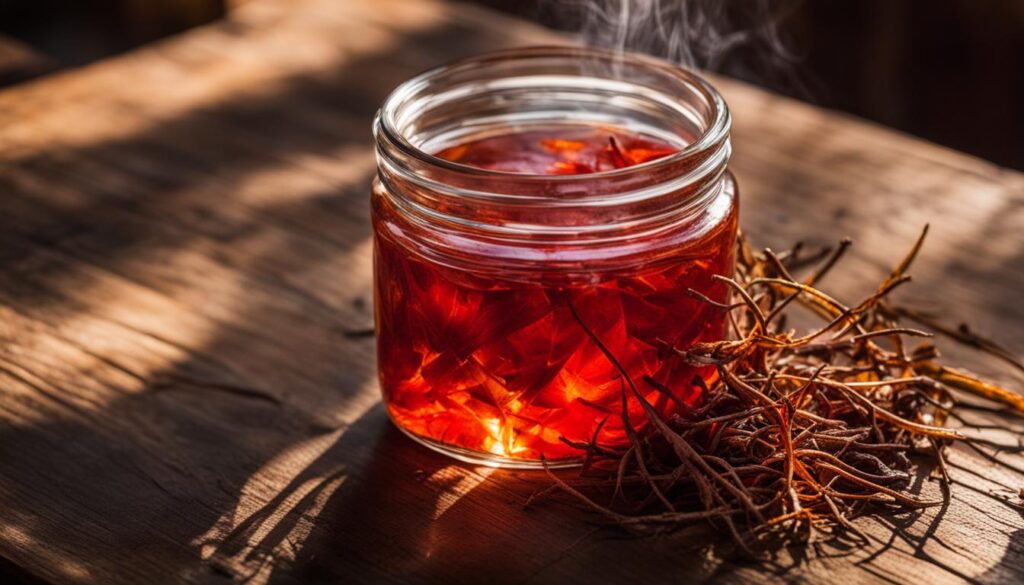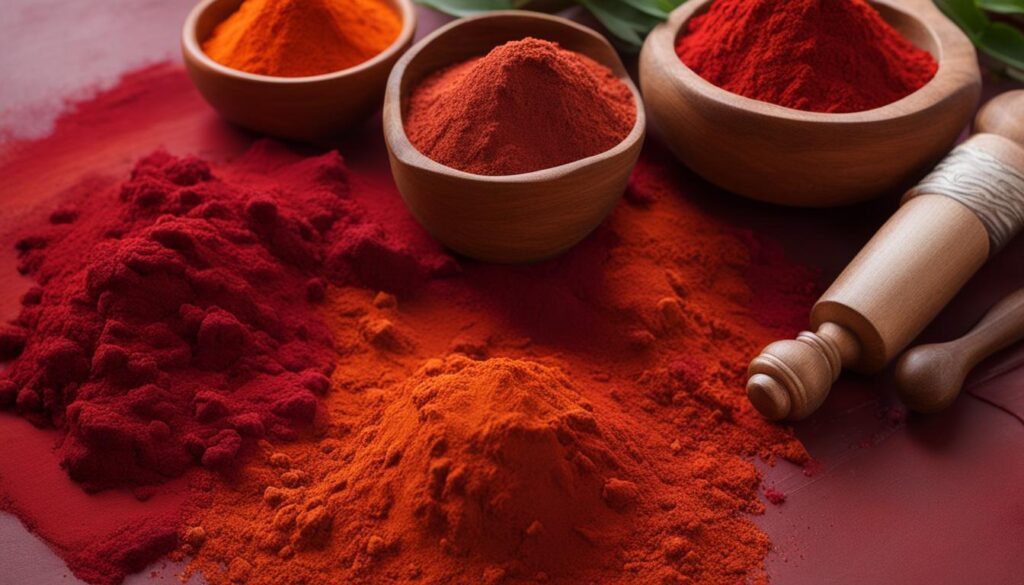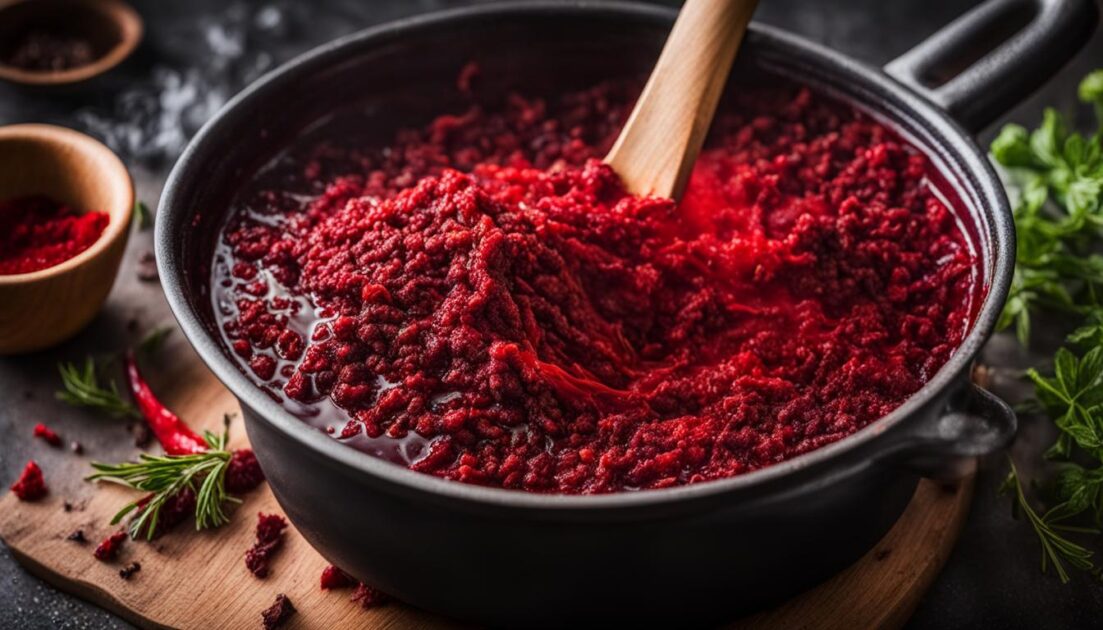Welcome to my guide on exploring the wonderful world of natural dyes! In this article, we will delve into the fascinating properties and uses of madder root, a versatile natural dye that has been cherished for centuries. Whether you are a seasoned natural dye enthusiast or a curious beginner, this guide will provide you with valuable insights on how to make the most of madder root in your dyeing projects.
Key Takeaways:
- Discover the benefits of using madder root in natural dyeing.
- Learn the step-by-step process of dyeing with madder root.
- Experiment with madder root powder to achieve vibrant colors.
- Explore the historical significance of madder root in the world of natural dyes.
- Find ethical and sustainable sources of madder root for your dyeing projects.
The Benefits of Using Madder Root
Madder root offers several benefits when used in natural dyeing. Its vibrant hues of reds, pinks, and purples make it a versatile and sought-after dye for various applications. The key compound found in madder root, alizarin, is responsible for its intense and long-lasting colors.
One of the unique advantages of madder root is its suitability for dyeing both hair and fabric. Whether you’re looking to add a pop of color to your textiles or experimenting with vibrant, naturally dyed hair, madder root is a fantastic option.
Throughout history, civilizations have recognized and utilized the dyeing properties of madder root. From ancient Egyptians to Greeks, Romans, and Vikings, madder root has been an integral part of dyeing traditions across the world.
The Versatility of Madder Root
As a natural dye, madder root offers a range of possibilities for creative expression. Whether you’re an artisan or a hobbyist, the versatility of madder root allows you to explore different natural dye techniques and achieve stunning outcomes.
Madder root can be utilized to create brilliant hues on various types of fabrics, including cotton, silk, wool, and linen. Its ability to produce vivid reds, pinks, and purples makes it a go-to choice for natural dye enthusiasts.
Whether you’re dyeing a garment or creating a textile artwork, madder root allows you to infuse your creations with vibrant and captivating colors that will stand the test of time.
To experience the benefits of madder root firsthand, it’s important to understand the dyeing process and techniques involved. By mastering the art of madder dyeing, you can unlock a world of endless possibilities for your creative projects.
Continue reading to learn more about the dyeing process with madder root, historical significance, and tips for achieving exquisite colors with madder root powder.
The Dyeing Process with Madder Root
To achieve vibrant colors with madder root, proper preparation is necessary. The fabric or fiber should be prewashed with a detergent like synthrapol. Mordanting the fabric is crucial for color absorption, and alum is commonly used as a mordant.
The madder root is simmered in water for about an hour, and the fabric is then added to the dyebath and simmered for another hour. Stirring the dyebath periodically ensures even dyeing.
The dyebath can be reused for lighter shades, and additional materials can be added to create different color variations.
Step-by-Step Guide to Dyeing with Madder Root:
- Prewash the fabric or fiber with a detergent like synthrapol.
- Mordant the fabric using alum or another suitable mordant.
- Simmer the madder root in water for approximately one hour.
- Add the fabric to the dyebath and simmer for an additional hour.
- Stir the dyebath periodically for even dyeing.
- Reuse the dyebath for lighter shades or experiment with additional materials for different color variations.
The madder root dyeing process offers endless possibilities for natural dye techniques and adds a touch of eco-friendly beauty to your fabrics.
Tips for Using Madder Root Powder
Madder root powder is a versatile and effective natural dyeing ingredient that can help you achieve vibrant colors in your dye projects. Whether you’re a novice or an experienced dyer, these tips will help you get the most out of using madder root powder.
1. Use the Right Ratio
To ensure optimal color absorption, it is recommended to use approximately 100g of madder powder per 100g of fabric. This ratio will help you achieve rich and saturated colors. However, feel free to experiment with different ratios to create unique shades.
2. Explore Different Mordants
The choice of mordant can influence the final color outcome. Alum is a commonly used mordant for madder root dyeing, but you can also experiment with other mordants such as iron or copper to create different shades and effects. Be sure to follow safety guidelines when working with mordants.
3. Control the Dyebath Temperature
Madder root dyeing should be done at a controlled temperature. Avoid exceeding 200 degrees Fahrenheit, as higher temperatures can degrade the dye and affect the color outcome. Use a thermometer to monitor the temperature throughout the dyeing process.
4. Overdye for Unique Color Variations
If you’re looking to create interesting color variations, consider overdyeing with other natural dyes like indigo. Overdyeing can produce beautiful and complex shades that add depth to your fabric. Experiment with different combinations and layering techniques to achieve your desired results.
| Tip | Description |
|---|---|
| 1 | Use the right ratio of madder root powder to fabric for optimal color absorption. |
| 2 | Experiment with different mordants to create unique shades and effects. |
| 3 | Monitor and control the dyebath temperature to prevent dye degradation. |
| 4 | Try overdyeing with other natural dyes to achieve interesting color variations. |
By following these tips and techniques, you can unlock the full potential of madder root powder and create exquisite colors in your natural dyeing projects.
Historical Significance of Madder Root
Madder root holds a prominent place in the history of natural dyeing, tracing back centuries and leaving a notable impact on various civilizations. Cultures such as the ancient Egyptians, Greeks, Romans, and Vikings recognized the value of madder root and utilized it for their dyeing practices. Archaeological excavations have unveiled madder-dyed fabrics, showcasing the enduring presence of this remarkable plant throughout time.
The Turkey Red process, a dyeing technique that emerged in the 18th century, prominently featured madder root. This complex process involved multiple steps and required skillful artisans to achieve the vibrant red hues synonymous with Turkey Red. Madder root, along with other ingredients, contributed to the remarkable coloration and durability of textiles produced using this method.
“Madder root has been a staple in the world of natural dyeing for centuries, providing rich and lasting colors to fabrics across different cultures and civilizations.”
Despite the advent of synthetic dyes in the 1860s, madder root has continued to be esteemed by modern artisans for its historical significance and exceptional beauty. Its ability to produce a wide range of colors, from vibrant reds to softer pinks and oranges, makes it a cherished ingredient in the world of natural dyeing. The enduring appeal of madder root lies not only in its deep-rooted historical roots but also in its ability to evoke a sense of tradition and connection to the past.

| Civilizations | Time Period |
|---|---|
| Ancient Egyptians | 3000 BCE – 30 BCE |
| Greeks | 1200 BCE – 146 BCE |
| Romans | 753 BCE – 476 CE |
| Vikings | 793 CE – 1066 CE |
Sourcing and Harvesting Madder Root
Madder root, renowned for its benefits and uses in natural dyeing, is primarily cultivated in the Aegean region under the expertise of local farmers. To ensure the preservation of this ancient tradition, ethical and sustainable practices are followed throughout the sourcing and harvesting process. The roots, once harvested, undergo a natural drying process and are then carefully processed into powder, ready for use in dye projects.
By choosing organic madder root powder, artisans not only support sustainable practices but also embrace the beauty of eco-friendly dyeing. Let’s delve deeper into the farming, harvesting, and processing methods involved in obtaining this remarkable natural dye source.
The Cultivation of Madder Root
The Aegean region provides an ideal climate for madder root cultivation. The soil composition, temperature, and sunlight in this region contribute to the growth of healthy and vibrant madder plants.
Local farmers follow traditional farming practices, utilizing their expertise and knowledge passed down through generations. These farmers understand the importance of organic cultivation, avoiding the use of harmful pesticides and chemicals.
The Harvesting Process
Once the madder plants reach maturity, the roots are carefully harvested. Skilled farmers use their experience to determine the optimum time for harvesting, ensuring that the roots are rich in color and dye properties.
The harvesting process involves gently digging up the roots from the soil. Great care is taken to prevent damage to the roots and preserve their quality for dyeing purposes.
Natural Drying and Processing
After harvesting, the madder roots are naturally dried to remove excess moisture. This drying process is crucial for maintaining the potency of the roots and preventing spoilage.
Once dried, the roots are meticulously processed into a fine powder. The grinding process breaks down the roots into consistent particles, ensuring optimal dye extraction during the dyeing process.
It’s important to source madder root powder from reputable suppliers committed to sustainable practices and ethical sourcing. By supporting these producers, artisans contribute to the preservation of traditional dyeing techniques while creating stunning, eco-friendly dye projects.
| Benefits of Sourcing Ethical Madder Root | Benefits of Sourcing Organic Madder Root Powder |
|---|---|
|
|
Color Variations with Madder Root
Madder root is renowned for its ability to produce a wide range of captivating colors in natural dyeing. By exploring different mordants and techniques, artisans can unlock a spectrum of hues that includes vibrant reds, pinks, and purples.
One fascinating aspect of madder root dyeing is the option to create unique color combinations through overdyeing with other natural dyes, such as indigo. This creative approach opens up endless possibilities for artisans to experiment and achieve one-of-a-kind shades.
Furthermore, even after the initial dyeing process, the spent dyebath can still be utilized to achieve lighter shades. By carefully adjusting the pH of the dyebath using substances like citric acid or vinegar, artisans can create additional color variations and expand their creative repertoire.

Color Variations Achievable with Madder Root
| Mordant | Color |
|---|---|
| Alum | Pale pink |
| Tin | Bright red |
| Iron | Deep purple |
| Copper | Orange |
The table above highlights some of the color variations achievable with madder root dyeing when different mordants are used. Each mordant imparts a unique tone, allowing artisans to create a diverse palette of colors on various fabrics.
“The versatility of madder root never ceases to amaze me. It has enriched my dyeing projects with its vibrant colors and endless possibilities.” – Jessica, Natural Dye Enthusiast
Testimonial from a Satisfied Customer
I would like to share Ceilidh’s experience with Themazi’s madder root powder. As a passionate natural dyeing enthusiast, Ceilidh was delighted with the fantastic results she achieved using this high-quality product.
“I have always been drawn to the vibrant colors that madder root dye produces, so I decided to give Themazi’s madder root powder a try. I was not disappointed! The rich reds and salmon pinks I obtained were simply stunning.”
When using Themazi’s madder root powder, Ceilidh also combined it with mordants to enhance the color intensity, resulting in even more beautiful and vibrant shades. She was impressed with the effectiveness and quality of the madder root powder, which allowed her to create eye-catching colors for her dyeing projects.
If you’re looking for a reliable and top-quality madder root powder to elevate your dyeing endeavors, Themazi’s product is definitely worth considering. Take it from Ceilidh’s experience – you won’t be disappointed!
The Magic of Madder Root Powder
Embrace the natural beauty and historical significance of organic madder root powder in your dyeing journey. Utilize the versatility of madder root powder to create stunning and enchanting colors on your fabrics. By harnessing the magic of madder, you can elevate your creative expressions and leave a lasting impact on both history and the environment.
Whether you’re a seasoned natural dye enthusiast or just starting out, madder root powder offers a range of benefits that make it a valuable ingredient in your dyeing projects. The vibrant hues it produces, along with its longstanding use in various civilizations, testify to its effectiveness and enduring appeal.
“Madder root powder has truly transformed my dyeing experience. The rich and intense colors it yields are simply breathtaking. I love creating unique patterns and designs using this magical ingredient. It has opened up a whole new world of possibilities for my fabric art.” – Ceilidh, Dyeing Enthusiast
From its deep reds to delicate pinks, madder root powder allows you to achieve a spectrum of captivating colors. Its main active compound, alizarin, is responsible for the vivid and lasting hues it imparts to your fabrics. Whether you’re dyeing natural fibers like cotton or silk, or experimenting with yarns, madder root powder brings a touch of natural beauty to your creations.
To unleash the full potential of madder root powder, you can experiment with different techniques and recipes. Add it to your dye bath along with mordants like alum or iron to create unique color variations. Overdyeing with other natural dyes, such as indigo, can also yield mesmerizing effects that reflect your artistic vision.

| Benefits of Madder Root Powder |
|---|
| Produces vibrant reds, pinks, and purples |
| Offers historical significance in natural dyeing |
| Can be used on various natural fibers |
| Allows for experimentation with different colors and shades |
| Enhances the beauty of your fabric art |
With madder root powder, you have the power to create unique and captivating colors while honoring the traditions of the past. Let the magic of madder root powder inspire your dyeing journey and unlock a world of artistic possibilities.
Production Process of Madder Root Powder
At Themazi, we take pride in preserving the ancient tradition of madder dyeing and providing artisans with a reliable source of high-quality madder root powder. Our production process starts with the careful cultivation and harvest of madder root by local experts in villages, ensuring ethical and sustainable practices.
The freshly harvested roots are then naturally dried to preserve their potency and quality. Once dried, the roots are thoroughly washed to remove any impurities and dirt. This ensures that our madder root powder is pure and free from contaminants.
After washing, the roots are finely powdered in-house using state-of-the-art equipment. This process ensures that the madder root powder is of consistently high quality, with a fine texture that is easy to work with in dyeing projects.
By controlling the entire production process, from cultivation to powdering, we maintain the integrity and authenticity of our madder root powder. This allows artisans like you to confidently use our product, knowing that it is sourced and processed with a commitment to excellence.
Benefits of Themazi’s Madder Root Powder:
- High-quality madder root powder for vibrant dye colors
- Ethically and sustainably sourced roots
- Natural drying and careful washing for purity
- Consistently fine texture for easy application
- Preserves the ancient tradition of madder dyeing
With Themazi’s madder root powder, you can confidently explore the world of natural dyeing and create stunning colors on your fabrics. Experience the benefits of our meticulously produced madder root powder and elevate your dyeing projects to new heights of beauty.
Enjoy the Art of Natural Dyeing with Madder Root
Unlock your creativity and embark on a journey of natural dyeing with the extraordinary properties of madder root. This ancient dye has stood the test of time, offering a plethora of possibilities for fabric and hair dyeing. Whether you are an experienced natural dyer or just starting out, madder root is a must-have in your dyeing toolkit.
When it comes to fabric dyeing, madder root truly shines. With its vibrant reds and captivating pinks, it can transform any textile into a work of art. From delicate silk scarves to sturdy cotton garments, madder root brings beauty and depth to every fabric it touches. Its unique shades add an element of sophistication and individuality to your creations.
But it doesn’t stop there. Madder root is not only a favorite among textile artists but also among those seeking natural alternatives for hair dyeing. Its rich pigments can impart stunning red hues to your tresses, allowing you to achieve that head-turning hairstyle you desire. Say goodbye to harsh chemicals and embrace the natural beauty of madder root.
FAQ
How can I use madder root in natural dyeing projects?
To use madder root, prewash your fabric or fiber with a detergent like synthrapol. Mordant the fabric with alum to enhance color absorption. Simmer the madder root in water for an hour, then add the fabric to the dyebath and simmer for another hour. Stir the dyebath periodically for even dyeing.
What colors can madder root produce in natural dyeing?
Madder root can produce vibrant reds, pinks, and purples. It offers a wide range of color variations when combined with different mordants and techniques.
Can madder root be used to dye hair?
Yes, madder root can be used to dye hair. Its vibrant red hues can create stunning results when used as a natural hair dye.
What is the historical significance of madder root in natural dyeing?
Madder root has been used for centuries by ancient civilizations like the Egyptians, Greeks, Romans, and Vikings. It is a testament to the enduring beauty and effectiveness of this natural dye.
How is madder root sourced and harvested?
Madder root is mainly cultivated in the Aegean region and harvested by local experts. Ethical and sustainable practices are followed to preserve this ancient tradition.
Can madder root be reused in dyeing projects?
Yes, both fresh and “spent” madder root can be used in dyeing. Spent madder root can still boost fermentation and produce vibrant colors.
How can madder root powder be used in natural dyeing?
Madder root powder can be used to achieve vibrant colors in dyeing projects. Experiment with different mordants and techniques to achieve a wide range of colors and shades.
What are the benefits of using madder root in natural dyeing?
Madder root offers versatile color options and can be used for fabric and hair dyeing. Its active compound, alizarin, is responsible for the intense hues it imparts.
How does madder root powder enhance natural dyeing projects?
Madder root powder can yield vibrant and captivating colors when used in dyeing projects. It offers a sustainable and eco-friendly alternative to synthetic dyes.
What is the production process of madder root powder?
Madder root is grown, dried, and processed into powder in-house. Ethical and sustainable practices are followed during the production process to ensure high-quality madder root powder.
How can I achieve different color variations with madder root?
Experiment with different mordants, techniques, and overdyeing with other colors like indigo to create unique color combinations. Adjusting the pH of the dyebath can also produce additional color variations.
Are there any testimonials regarding the use of madder root powder?
Yes, Ceilidh, a natural dyeing enthusiast, expressed her satisfaction with Themazi’s madder root powder. She achieved rich reds and salmon pinks when using the powder in conjunction with mordants.






